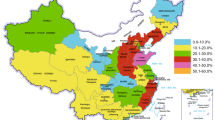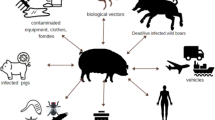Abstract
Classical swine fever (CSF) is one of the most important viral diseases of pigs with high economic impact. The causative agent, Classical swine fever virus (CSFV) is a member of genus Pestivirus in family Flaviviredae and is structurally and antigenically related to other members of the genus. The identification of virus strains and genotypes can conveniently be used to trace the origin and patterns of virus spread, which contribut substantially in control strategies. In the present study, we have partially sequenced and analysed the 5′ untranslated region (UTR) and E2 regions of CSFV clinical samples (n = 24) from various parts of the country. Among the samples, the sequence alignment of 5′UTR and E2 regions revealed 96.7–100 and 94.7–100% identities at the nucleotide level, respectively. The samples under study showed the close resemblance to the other CSFV isolates reported in India. In phylogenetic analysis, all the field samples were clustered in subgroup 2.2. Thus the study presents a further phylogenetic evidence for the emergence of subgroup 2.2 CSFV replacing the predominant subgroup 1.1 viruses in India. As the information regarding the molecular epidemiology the CSFV in india is very little, generation of such epidemiological data is warranted to help in comprehensing the nationwide disease control program to sustain the growth of pig industry in India.


Similar content being viewed by others
References
Ahamad DB, Azmi S, Sood S, Sharma AK, Kumar GS. An outbreak of Classical swine ever (CSF) in Jammu region (India): a pathomorphological study. Indian J. Vet.Pathol. 2009;33:101–2.
Barman NN, Bora DP, Khatoon E, Mandal S, Rakshit A, Rajbongshi G, Depner K, Chakraborty A, Kumar S. Classical swine fever in wild hog: report of its prevalence in northeast India. Transbound. Emerg. Dis. 2014;. doi:10.1111/tbed.12298.
Barman NN, Gupta R, Bora D, Kataria R, Tiwari AK, Roychoudhury P. Molecular characterization of classical swine fever virus involved in the outbreak in mizoram. Indian J. Virol. 2010;21(1):76–81.
Bhaskar N, Ravishankar C, Rajasekhar R, Sumod K, Sumithra TG, John K, Mini M, Ravindran R, Shaji S, Aishwarya J. Molecular typing and phylogenetic analysis of classical swine fever virus isolates from Kerala, India. Virus Dis. 2015;26(4):260–6.
Bjorklund H, Lowings P, Stadejek T, Vilcek S, Greiser-Wilke I, Paton D, Belak S. Phylogenetic comparison and molecular epidemiology of classical swine fever virus. Virus Genes. 1999;19:189–95.
Chakraborty S, Veeregowda BM, Chandranaik BM, Rathnamma D, Isloor S, Venkatesha MD, Leena G, Veeresh H, Patil SS. Molecular characterization and genogrouping of classical swine fever virus isolates from field outbreaks. Ind. J. Anim. Sci. 2011;81(8):21–5.
Deng MC, Huang CC, Huang TS, Chang CY, Lin YJ, Chien MS, Jong MH. Phylogenetic analysis of classical swine fever virus isolated from Taiwan. Vet. Microbiol. 2005;106:187–93.
Desai GS, Sharma A, Kataria RS, Barman NN, Tiwari AK. 5′UTR-based phylogenetic analysis of classical swine fever virus isolates from India. Acta Virol. 2010;54:79–82.
Felsenstein J. Confidence limits on phylogenies: an approach using the bootstrap. Evolution. 1985;39:783–91.
Fritzemeier J, Teuffert J, Greiser-Wilke I, Staubach C, Schluter H, Moennig V. Epidemiology of classical swine fever in Germany in the 1990s. Vet. Microbiol. 2000;77:29–41.
Greiser-Wilke I, Depner K, Fritzemeier J, Haas L, Moennig V. Application of a computer program for genetic typing of classical swine fever virus isolates from Germany. J. Virol. Methods. 1998;75:141–50. doi:10.1016/S0166-0934(98)00109-8.
Kaden V, Hanel A, Renner C, Gossger K. Oral immunisation of wild boar against classical swine fever in Baden-Wurttemberg: development of the seroprevalences based on the hunting bag. Eur. J. Wildl. Res. 2005;51(2):101–7.
Kimura M. A simple method for estimating evolutionary rates of base substitutions through comparative studies of nucleotide sequences. J. Mol. Evol. 1980;16:111–20. doi:10.1007/BF01731581.
Krishnamurthy D, Adlakha SC. A preliminary report on the Swine fever epidemic in Uttar Pradesh, Indian. Vet J. 1962;39:406–19.
Kumar R, Rajak KK, Chandra T, Muthuchelvan D, Saxena A, Chaudhary D, Kumar A, Pandey AB. Sequence-based comparative study of Classical swine fever virus genogroup 2.2 isolate with pestivirus reference strains. Vet. World. 2015;8(9):1059–62.
Kumar R, Rajak KK, Chandra T, Thapliyal A, Muthuchelvan D, Sudhakar SB, Sharma K, Saxena A, Raut SD, Singh VK, Ahmad Z, Kumar A, Chaudhary D, Singh RK, Pandey AB. Whole-genome sequence of a classical swine fever virus isolated from the Uttarakhand state of India. Genome Announc. 2014;2(3):e00371-14.
Laddomada A. Incidence and control of CSF in wild boar in Europe. Vet. Microbiol. 2000;73:121–30.
Leifer I, Hoffmann B, Hoper D, BruunRasmussen T, Blome S, Strebelow G, Horeth-Bontgen D, Staubach C, Beer M. Molecular epidemiology of current classical swine fever virus isolates of wild boar in Germany. J. Gen. Virol. 2010;91:2687–97.
Lowings JP, Ibata G, Needham J, Paton DJ. Classical swine fever diversity and evoluation. J. Gen. Virol. 1996;77:1311–21. doi:10.1099/0022-1317-77-6-1311.
Malmarugan A, Sundaram M, Rajeswar JJ. An Outbreak of Classical swine fever in indigenous pigs in Tamilnadu, India. Int. J. Adv. Vet. Sci. Technol. 2014;3(1):145–8.
Mintiens K, Verloo D, Venot E, Laevens H, Dufey J, Dewulf J, Boelaert F, Kerkhofs P, Koenen F. Estimating the probability of freedom of classical swine fever virus of the East-Belgium wild-boar population. Prev. Vet. Med. 2005;70:211–22.
Nandi S, Muthuchelvan D, Ahuja A, Bisht S, Chander V, Pandey AB, Singh RK. Prevalence of classical swine fever virus in India: a 6-year study 2004–2010. Transbound Emerg Dis. 2011;58:461–3.
Pan CH, Jong MH, Liu HF, Lai SS. Phylogenetic analysis of classical swine fever virus in Taiwan. Arch. Virol. 2005;150:1101–19.
Patil SS, Hemadri D, Shankar BP, Raghavendra AG, Veeresh H, Sindhoora B, Chandan S, Gagendragad MR, Sreekala K, Prabhudas K. Genetic typing of recent classical swine fever isolates from India. Vet. Microbiol. 2010;141(34):367–73.
Patil SS, Hemadri D, Veeresh H, Sreekala K, Gajendragad MR, Prabhudas K. Phylogenetic analysis of NS5B gene of classical swine fever virus isolates indicated plausible Chinese origin of Indian subgroup 2.2 viruses. Virus Gene. 2012;44:104–8.
Paton DJ, McGoldrick A, Greiser-Wilke I, Parchariyanon S, Song JY, Liou PP, Stadejek T, Lowings JP, Bjorklund H, Belak S. Genetic typing of classical swine fever virus. Vet. Microbiol. 2000;73:137–57.
Postel A, Jha VC, Schmeiser S, Becher P. First molecular identification and characterization of classical swine fever virus isolates from Nepal. Arch. Virol. 2013;158:207–10.
Rathnapraba S, Vadivoo VS, Manoharan S, Logesh K, Kumanan K. Molecular detection of classical swine fever from field outbreak. Indian J. Vet. Pathol. 2012;36(1):22–7.
Ravishankar C, Priya PM, Mini M, Rameshkumar P, Senthamilselvan P, Jayesh V, Sunil KS, Sharmadha MK, Sreekumaran T, Jayaprakasan V. First confirmed occurrence of classical swine fever in Kerala state, India. J. Swine Health Prod. 2007;15:156–9.
Sapre SN, Moghe RG, Bhagwat SV, Choudhary PG, Purohit BL. Observations on swine fever in Maharashtra. Indian Vet. J. 1962;39:527–9.
Sarma DK, Mishra N, Vilcek S, Rajukumar K, Behera SP, Nema RK, Dubey P, Dubey SC. Phylogenetic analysis of recent Classical swine fever virus (CSFV) isolates from Assam, India. Comp. Immunol. Microbiol. Infect. Dis. 2009;725:1–5.
Sarma DK, Mishra N, Vilcek S, Rajukumar K, Behera SP, Nema RK, Dubey P, Dubey SC. Phylogenetic analysis of recent classical swine fever virus (CSFV) isolates from Assam, India. Comp. Immunol. Microbiol. Infect. Dis. 2011;34:11–5.
Shivaraj DB, Patil SS, Rathnamma D, Hemadri D, Isloor S, Geetha S, Reddy GBM, Sharada R, Rahman H. Phylogenetic analysis of recent Classical swine fever virus isolates (CSFV) from Karnataka, India. Indian J. Anim. Sci. 2014;84(3):236–9.
Singh VK, Bhadouriya S, Kumar R, Rajak KK. Comparison of RNA isolation methods for detection of Classical swine fever virus from tissue samples. Indian J. Comp. Microbiol. Immunol. Infect. Dis. 2015;36(2):71–5.
Tamura K, Stecher G, Peterson D, Filipski A, Kumar S. MEGA6: molecular evolutionary genetics analysis version 6.0. Mol. Biol. Evol. 2013;30(12):2725–9. doi:10.1093/molbev/mst197.
Thiel HJ, Collett MS, Gould EA, Heinz FX, Houghton M, Meyers G, Purcell RH, Rice CM. Family flaviviridae. In: Fauquet CM, Mayo MA, Maniloff J, Desselberger U, Ball LA, editors. Virus taxonomy: VIIIth report of the ICTV. London: Elsevier/Academic Press; 2005. p. 979–96.
Thompson JD, Higgins DG, Gibson TJ. CLUSTAL W: improving the sensitivity of progressive multiple sequence alignment through sequence weighting, position-specific gap penalties and weight matrix choice. Nucleic Acids Res. 1994;22:4673–80.
Tu C, Lu Z, Li H, Yu X, Liu X, Li Y, Zang H, Yin Z. Phylogenetic comparision of classical swine fever virus in China. Virus Res. 2011;81:29–37.
Uttenthal A, Le Potier MF, Romero L, De Mia GM, Floegel-Niesmann G. Classical swine fever (CSF) marker vaccine Trial I challenge studies in weaner pigs. Vet. Microbiol. 2001;83:85–106.
Wensvoort G. Topographical and functional mapping of epitopes on Hog cholera virus with monoclonal antibodies. J. Gen. Virol. 1989;70(11):2865–76.
Zanardi G, Macchi C, Sacchi C, Rutili D. Classical swine fever in wild boar in the Lombardy region of Italy from 1997 to 2002. Vet. Record. 2003;152:461–5.
Zhang H, Cao HW, Wu ZJ, Cui YD. A review of molecular characterization of classical swine fever virus (CSFV). Israel J Vet Medicine. 2011;66(3):89–95.
Acknowledgement
The authors are grateful to the Director of the Institute for providing the necessary facilities to carry out this work. This study was carried out under a network project on classical swine fever, with special reference to the northern region (RGCB/DBT-Swine/PMD/CSF- 4/11/08 dt 24/11/08), funded by the Department of Biotechnology (DBT), Ministry of Science and Technology, Government of India, New Delhi.
Author information
Authors and Affiliations
Corresponding author
Rights and permissions
About this article
Cite this article
Singh, V.K., Rajak, K.K., Kumar, R. et al. Changing pattern of classical swine fever virus genogroup from classical 1.1 to emerging 2.2 in India. VirusDis. 28, 174–181 (2017). https://doi.org/10.1007/s13337-017-0368-6
Received:
Accepted:
Published:
Issue Date:
DOI: https://doi.org/10.1007/s13337-017-0368-6




